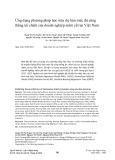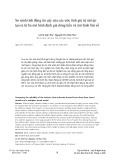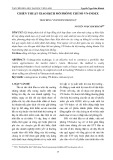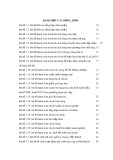
http://www.iaeme.com/IJM/index.asp 134 editor@iaeme.com
International Journal of Management (IJM)
Volume 8, Issue 3, May–June 2017, pp.134–142, Article ID: IJM_08_03_014
Available online at
http://www.iaeme.com/ijm/issues.asp?JType=IJM&VType=8&IType=3
Journal Impact Factor (2016): 8.1920 (Calculated by GISI) www.jifactor.com
ISSN Print: 0976-6502 and ISSN Online: 0976-6510
© IAEME Publication
IMPACT OF CAPITAL MARKET ON NIGERIAN
ECONOMY, 1981 - 2014
Ugwuanyi, Charles Uche (Ph.D)
Department Of Economics,
Michael Okpara University Of Agriculture, Umudike,
Abia State, Nigeria
ABSTRACT
This study examined the impact of the capital market on Nigerian economy. Time
series data were collected on Real Gross Domestic Product, Market Capitalization,
All Share Index and Turnover Ratio from 1981 - 2014. The study employed Unit root,
Cointegration and Granger Causality Tests as well as Ordinary Least Square method
in the empirical analysis. The unit root tests show that the variables were not
stationary at level but all became stationary at first difference. They were said to be
integrated of the order one, 1(1) at first difference. The Cointegration Test revealed
that all the variables were cointegrated, showing a long-run equilibrium relationship
between capital market and Nigerian economy. The Granger Causality Test shows a
unidirectional causality between the variables in the model. The OLS result indicates
that the coefficient of determination, i.e. the R-squared has a value of 0.988849. This
implies that 98 percent changes in the Real Gross Domestic Product of Nigeria could
be attributed to the independent variables. The MCAP & TURNR have coefficient
values of 0.899656 and 0.375083 with t-statistic of 14.60231 and 2.879237
respectively. The All Share Index (ASHI) has negative coefficient value of -0.265177
and t-statistic value of -5.667988. The implication of these findings is that the capital
market in Nigeria appears not to be contributing enough to the economy as ASHI seen
in economic literature as a better stock market indicator than MCAP and TURNR has
negative impact on the economy. The findings support the Efficient Market
Hypothesis. The study recommend improved information on past performances of
companies, equity returns, equity prices, and stock/company listing to avoid
unreasonable speculation by investors in financial assets. It will improve the
performance of capital market in Nigeria.
Key words: Capital Market, Nigerian Economy, Efficient Market Hypothesis, Equity
returns, financial assets.
Cite this Article: Ugwuanyi, Charles Uche (Ph.D), Impact of Capital Market on
Nigerian Economy, 1981-2014. International Journal of Management, 8 (3), 2017, pp.
134–142. http://www.iaeme.com/IJM/issues.asp?JType=IJM&VType=8&IType=3

Impact of Capital Market on Nigerian Economy, 1981-2014
http://www.iaeme.com/IJM/index.asp 135 editor@iaeme.com
1. INTRODUCTION
The perception of the economic policy in Nigeria and elsewhere is that the capital market
is a driver or lubricant that keeps turning the wheel of the economy to growth and
development because of its imperative functions of not just mobilizing long term funds and
channeling them to productive investment but also efficiently allocating these funds to
projects that make best returns to fund owners [1], [2], [3], [4], and [5]. Today, the activities
and performance of capital market in Nigeria have much wider implications and these arise
partly because of the growing influence of ideas and structure associated with the concept of
democracy. The capital market has been identified as an institution that contributes to the
socio-economic growth and development of emerging and developed economies.
These are made possible through some of the vital roles it plays, such as channeling
resources, promoting reforms to modernize the financial sector, financial intermediation
capacity to link deficit to the surplus sector of the economy and as a veritable tool in the
mobilization and allocation of savings among competitive uses which are critical to the
growth and efficiency of the economy [6]. [7], argues that a nation requires a lot of local and
foreign investments to attain sustainable economic growth and development. [8], states that
capital market contributes to economic growth through the specific services it performs either
directly or indirectly, notable among these functions are: mobilization of savings, creation of
liquidity, risk diversification, improved dissemination and acquisition of information and
enhanced incentive for corporate control. However, the paucity of long-term capital has posed
the greatest predicament to economic growth and development in Nigeria.
Therefore, using the cointegration test, Granger causality test and Ordinary Least Square
analysis we studied the interaction of capital market variables in increasing economic growth
in Nigeria. This is very important because share index and other variables determine the
investors’ response in capital market.
The purpose of this article is to identify the long-run effect of All Share Index, Market
Capitalization and Turnover ratio on Nigerian economy.
The article is organized as follows: Section one introduces the study while section two
reviews the related literatures. Section three highlights the methodology employed in the
study and the sources of data. Section four presents and discusses the empirical results.
Lastly, section five provides the conclusions and policy implications.
2. LITERATURE REVIEW
The Nigerian economy has over the years been subjected to series of social, political and
economic policies and reforms. The policy and reform journeys saw the need to encourage
private capital in development, and established Nigerian Stock Exchange (NSE) in 1961.
However, the Capital Market effectively started operations in Nigeria on 5th June, 1961,
under the provision of the Lagos Stock Exchange Act 1961, which transformed into the
Nigerian Stock Exchange in December 1977 as a result of the review of the Nigerian
Financial System [9]. The Securities and Exchange Commission (SEC) was established in
1979 through the SEC Act 1979, to regulate the capital market, but commenced actual
operation in 1980. Since then, various forms of financial instruments have been issued in the
capital market by new and existing businesses to finance product development, new projects
or general business expansion.
The capital market is divided into the primary and the secondary market. The primary
market or the new issues market provides the avenue through which government and
corporate bodies raise fresh funds through the issuance of securities which is subscribed to by
the public or selected group of investors. The secondary market provides an avenue for sale
and purchase of existing securities.

Ugwuanyi, Charles Uche (Ph.D)
http://www.iaeme.com/IJM/index.asp 136 editor@iaeme.com
[10], found that the secondary market activities have impacted more on Nigeria per capita
income by tending to grow stock market earnings through wealth than the primary market.
Many studies have been carried out on capital market and economic growth in Nigeria.
These studies have produced differing findings and conclusions.
Study by [11], found that the total value of stock has a negative effect on GDP growth
rate. According to [12], the capital market in Nigeria has the potentials of growth inducing but
it has not contributed meaningfully to the economic growth of Nigeria. Another study by [13]
found that the capital market has an insignificant impact on the Nigerian economy.
In contrast to the above findings, studies by [14], [15], [16], [17], [18], [19], [20], [21] and
[22] conclude that positive relationship exists between capital market and economic growth in
Nigeria.
All these studies adopted basically the same methods of OLS and ECM, and variables
such as total value of stock, all share index, market capitalization, GDP, money supply,
interest rate e.t.c., but for different time frames.
In view of the above controversy in empirical outcomes, theoretically, this study is
anchored on Efficient Market Hypothesis developed by [23]. According to the Efficient
Market Hypothesis (EMH), financial markets are efficient or prices are efficient on traded
assets that have already reflected all known information and therefore are unbiased because
they represent the collective beliefs of all investors about future prospects. The hypothesis
posits that past information is useful in improving the predictive accuracy of equity returns
and equity prices tend to exhibit long memory or long range dependence on equity returns.
In a country, where the market is highly and unreasonably speculative, investors will be
discouraged from parting with their funds for fear of incurring financial losses. In such
situation, it has detrimental effect on economic growth of the country, meaning investors will
refuse to invest in financial assets. The implication is that companies cannot raise additional
capital for expansion. This suggests that efficiency of the capital market is a necessary
condition for economic growth
3. ECONOMETRIC METHODOLOGY
3.1. Model Specification
This paper uses Ordinary Least Squares technique, cointegration and Granger causality tests
to identify the relationship between capital market and economic growth of Nigeria.
The Ordinary Least Squares (OLS) provides satisfactory results for estimates of structural
parameters. It also involves decision on whether the parameters are statistically significant
and theoretically meaningful. The capital market - economic growth hypothesis was tested
according to four macroeconomic variables which were built upon the following augmented
function:
RGDP = f (ASHI, TURNR, MCAP) (1)
Where:
RGDP = Real Gross Domestic Product (as proxy for economic growth)
ASHI = All Share Index
TURNR = Turnover Ratio
MCAP = Market Capitalization
In a more explicit and econometric form, equation (1) can be stated as
RGDP
t
=α
0
+ α
1
ASHI
t
+ α
2
TURNR
t
+ α
3
MCAP
t
+ e
t
(2)
Where

Impact of Capital Market on Nigerian Economy, 1981-2014
http://www.iaeme.com/IJM/index.asp 137 editor@iaeme.com
α
0
is the constant term
α
1
- α
3
= coefficients of each of the variable
t = is the time trend and
e
t
is the stochastic random term
By log linearising, the model becomes;
log (RGDP
t
) = α
0
+ α
1
log (ASHI
t
) + α
2
log (TURNR
t
) + α
3
log (MCAP
t
) + e
t
(3)
where: log = Natural log.
3.2. Description of Data and Sources
We used annual data for the period 1981-2014. The annual variables were – Real Gross
Domestic Product (RGDP), Turnover Ratio (TURNR), All Share Index (ASHI) and Market
Capitalization (MCAP). Data were sourced from Securities and Exchange Commission
Annual Reports and Accounts (various years), Central Bank of Nigeria (CBN) Statistical
Bulletin (2014), National Bureau of Statistics Annual Reports for the various years.\
3.3. Estimation Technique
The study employed a four step procedure in order to determine the impact, long run and
causality relationships between capital market and economic growth.
First, the Augmented Dickey-Fuller (ADF) test was used to check whether each data
series is integrated and has a unit root.
Secondly, the results of the integration tests were then pursued by co-integration tests. The
existence of long run equilibrium (stationary) relationships among economic variables is
referred to in the literature as cointegration. The Johansen procedure was employed to
examine the question of cointegration. It provided not only an estimation methodology but
also explicit procedures for testing for the number of cointegrating vectors as well as for
restrictions suggested by economic theory in a multivariate setting.
Thirdly, Pair-wise Granger Causality Test was conducted to determine whether the current
and lagged values of one variable affect another. An implication of Granger representation
theories is that if two variables, say X
t
and Y
t
are cointegrated and each is individually 1(1),
then either X
t
must Granger-cause Y
t
or Y
t
must Granger-cause X
t
.
Lastly, the OLS was employed to provide the estimates of the structural parameters used
to verify the validity of the estimates and to determine whether they actually represent
economic theory.
4. EMPIRICAL RESULTS
4.1. Unit Root Test
We tested whether the relevant variables in equation (3) are stationary and to determine their
order of integration. The results of the ADF test were provided in table 1 and 2.
Table 1 Unit Root Test for Stationarity at Levels, (Intercept and Trend)
Variables ADF Test 5% Critical Order of Interpretation Remarks
LRGDP
LASHI
LTURNR
LMCAP
-2.128327
-2.368928
-2.288621
-2.437887
-3.552973
-3.557759
-3.557759
-3.557759
-
-
-
-
Not Stationary
Not Stationary
Not Stationary
Not Stationary
Note: Mackinnon (1991) critical value for rejection of hypothesis of unit root applied.
Source: Author’s estimation using Eviews 7.0.

Ugwuanyi, Charles Uche (Ph.D)
http://www.iaeme.com/IJM/index.asp 138 editor@iaeme.com
The result in table 1 shows that all the variables were not stationary at levels. This can be
seen by comparing the observed values (in absolute terms) of ADF test statistic with the
critical values (also in absolute terms) of the test statistic at the 5% level of significance. The
results in table 1 provide strong evidence of non stationarity. Therefore, the null hypothesis is
accepted and it is sufficient to conclude that there is a presence of unit root in the variables at
levels.
Table 2 Unit Root Test for Stationarity at First Difference (Intercept and Trend)
Variables ADF Test 5% Critical Order of Interpretation Remarks
LRGDP
LASHI
LTURNR
LMCAP
-5.279981
-5.463069
-5.177698
-4.345574
-3.557759
-3.557759
-3.557759
-3.557759
1(1)
1(1)
1(1)
1(1)
Stationary
Stationary
Stationary
Stationary
Note: Mackinnon (1991) critical value for rejection of hypothesis of unit root applied.
Source: Author’s estimation using Eviews 7.0.
The result in table 2 reveals that all the variables became stationary at first difference. On
the basis of this, the null hypothesis of non-stationarity is rejected and it is concluded that the
variables are stationary. This implies that all the variables are integrated of order one, i.e.
1(1).
4.2. Cointegration Test Result
Having confirmed the stationarity of the variables at 1(1), we proceeded to examine the
presence of cointegration among the variables. When cointegration relationships exist it
means that capital market and economic growth share a common trend and long-run
equilibrium as suggested theoretically. We employed the Johansen and Juselius multivariate
cointegration test. The model with lag I was chosen with the linear deterministic test
assumption and the result is presented in table 3.
Table 3 Unrestricted Cointegration Rank Test (Trace)
Hypothesized No. of
CE(S)
Eigen Value Trace Statistic 0.05 Critical
Value
Prob**
None*
At most 1*
At most 2*
At most 3*
0.767324
0.686026
0.537465
0.176530
114.6181
67.95856
30.88833
6.215291
47.85613
29.79707
15.49471
3.841466
0.0000
0.0000
0.0001
0.0127
Note: Trace test indicates 4 cointegrating eqn (s) at the 0.05 level
*denotes rejection of the hypothesis at the 0.05 level
**Mackinnon-Haug-Michelis (1999)
ρ
-values
Source: Author’s estimation using Eviews 7.0
Table 4 Unrestricted Cointegration Rank Test (Maximum Eigen Value)
Hypothesized No. of
CE(S)
Eigen Value Max-Eigen
Statistic
0.05 Critical Value Prob**
None*
At most 1*
At most 2*
At most 3*
0.767324
0.686026
0.537465
0.176530
46.65950
37.07023
24.67304
6.215291
27.58434
21.13162
14.26460
3.841466
0.0001
0.0001
0.0008
0.0127
Note: Max-Eigen value test indicates 4 cointegrating eqn (s) at the 0.05 level
*denotes rejection of the hypothesis at the 0.05 level






![Bảng kê mua vào không có hóa đơn: [Hướng dẫn/Mẫu] chi tiết](https://cdn.tailieu.vn/images/document/thumbnail/2019/20190620/nguyenyenyn117/135x160/4891560998594.jpg)













![Đề thi Tài chính cá nhân kết thúc học phần: Tổng hợp [Năm]](https://cdn.tailieu.vn/images/document/thumbnail/2025/20251015/dilysstran/135x160/64111760499392.jpg)


![Câu hỏi trắc nghiệm và bài tập Thị trường chứng khoán [mới nhất]](https://cdn.tailieu.vn/images/document/thumbnail/2025/20251001/kimphuong1001/135x160/75961759303872.jpg)


